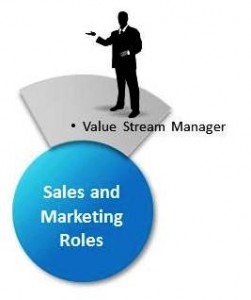Overview: The Value Stream Manager is responsible for maximizing return on investment (ROI) through his particular value stream of customer identification, customer value, customer acquisition, customer retention and customer monitoring (Value Stream Mapping Customer Value). He translates this value stream and assigns it in conjunction with the team coordinator to particular teams similar to how a typical sales manager would to his salespeople. The VSM and the team coordinator will routinely evaluate the outcomes to determine best fit. The VSM may work with multiple teams for his value stream. The VSM has profit and loss responsibility for the product/service. The VSM represents the Voice of the Market, which may be thousands of individual clients, distributors, brokers and agents. As with Scrum’s product owner, the VSM has the final authority. 
Again building on familiar ground you may want to equate this position to the Product Owner in Scrum, the Champion in a Six Sigma Project, Product Manager in Marketing or the Value Stream Manager in Lean. The short summary of their responsibilities: They assume the business interest of the product, service or value stream. They are the product/service owners and are held accountable for the commercial success of the product/service.
In Lean Sales and Marketing, the Value Stream Manager is held accountable for their Value Stream that is described in the 5Cs of Driving Market Share; Customer Identification, Customer Value, Customer Acquisition, Customer Retention and Customer Monitoring. In addition, the VSM has profit and loss responsibility for the product. Different than a Product Owner in Scrum, the VSM does represent the needs of the client in a project but is typically in contact with the client through the project team. The lean sales team actually performs the activities with the customer.
The VSM interacts with the team offering the priorities and reviewing the results with the Team Coordinator at each control point. It is important to note that as in Scrum there are two important principles. During iterations, the sales team has complete autonomy and should only be interacted with through the team coordinator. The other similarity is that the VSM is the one and only one person who has the final authority.
 The VSM will prioritize the backlog or the iterations in the marketing value stream. These needs are best expressed or written in the form of User Stories. Depending on the size and complexity of the organization, the Sales Team, the Team Coordinator and the Value Stream Manager may meet to discuss an iteration or an entire marketing cycle. During the meeting the user stories are prioritized and discussed by all involved in the process. The sales team then takes these stories and breaks them down into activities and create single, multiple iterations that may be completed in a linear or parallel fashion. When these stories are completed, a control gate review occurs where the results are accepted or rejected by the Value Stream Manager. The VSM, the Team and the Team Coordinator discuss improvements, the next stage or coordinate a handoff to another Team. This process should have a very strong focus on where the customer is in their decision making process and what the best way is to support them at this time.
The VSM will prioritize the backlog or the iterations in the marketing value stream. These needs are best expressed or written in the form of User Stories. Depending on the size and complexity of the organization, the Sales Team, the Team Coordinator and the Value Stream Manager may meet to discuss an iteration or an entire marketing cycle. During the meeting the user stories are prioritized and discussed by all involved in the process. The sales team then takes these stories and breaks them down into activities and create single, multiple iterations that may be completed in a linear or parallel fashion. When these stories are completed, a control gate review occurs where the results are accepted or rejected by the Value Stream Manager. The VSM, the Team and the Team Coordinator discuss improvements, the next stage or coordinate a handoff to another Team. This process should have a very strong focus on where the customer is in their decision making process and what the best way is to support them at this time.
Whereas the team concerns itself around the Voice of the Customer (VOC), the VSM must look at both VOC and Voice of Market (VOM). Following the 5Cs of Driving Market Share outline, the VSM must:
- Identify specific products/markets that offer organization best options for growth.
- Create a value model for each of targeted product or market.
- Clearly state the organization’s competitive value proposition.
- Identify the direction needed to enhance that value proposition.
- Monitor competitive value proposition.
The Value Stream Manager can be one person or an entire department. However, for the VSM to be effective, they have to have control over setting the priorities not only for the sales and marketing teams but many times for product development. Their decisions should be visible to the entire organization. As I like to put it, they hold the gold within the company: knowledge of both VOC and VOM. This visibility makes the role of VSM both demanding and a very rewarding one.
Related Information:
Identifying your Lean sales and marketing teams
What will your workplace be like in 2020?
What’s behind Collaboration and Value Networks?
SALES PDCA Framework for Lean Sales and Marketing
